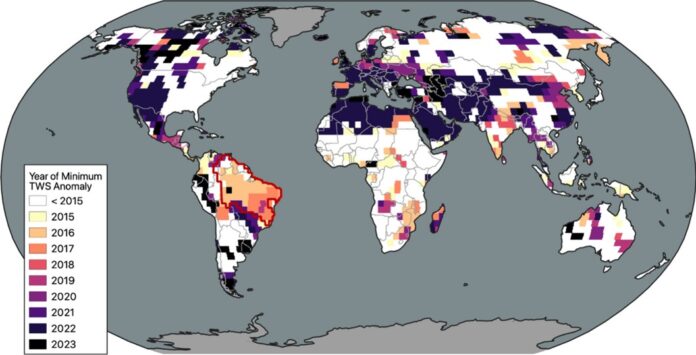A NASA study shows that land-based water sources including groundwater, soil moisture, surface waters, snow water equivalents and ice are all shrinking. A report appearing in Surveys in Geophysics analyzes measurements made by the GRACE and GRACE/FO satellites between 2015 and 2023. The data indicates the average freshwater land stores have dropped by 1,200 cubic kilometres (290 cubic miles) from measured levels between 2002 and 2014. The amount of loss is equivalent to 2.5 times the volume of Lake Erie.
The survey notes that droughts on five continents, back-to-back El Niño events, and global warming represent the leading contributors to the observed changes. On the world map at the top of this article, the area outlined in Northeastern South America, including much of the Amazon River basin, appears to have been the triggering point for the rise in drought conditions with evapotranspiration increasing in frequency and intensity and spreading around the world. The decline in land-based water resources is consistent with the nine warmest years recorded in the modern era.
When land surface water decreases it almost always is balanced by increases in ocean and atmospheric water levels. We lose only a tiny amount to the mantle when continental plates slide beneath others, and we lose a tiny amount of hydrogen to space amounting to less than 1 Gigaton per millennium. We also gain water from extraterrestrial material in the form of meteorites which contain water. So we can assume that the global water cycle on Earth is a closed system.
When land-based water declines is it reflected in sea level rise. This is particularly true for ice loss from the world’s glaciers that are under onslaught from rising atmospheric temperatures.
So how have NASA’s two GRACE satellites, launched to map Earth’s gravity field determined that land-based water levels are shrinking? Apparently, gravity field measurements give scientists the ability to see the movement and redistribution of water across the planet. Gravity field measurements help us to track changes in glaciers and continental ice sheets, sea levels, groundwater storage levels, ocean currents, and soil moisture.
The reason two satellites are needed is to precisely measure the tiny variations between them as each satellite passes over the same patch of planet recording changes as small as 10 micrometres.
Each day the two satellites deliver 200 atmospheric temperature and humidity profiles. They record ice sheet and alpine glacier mass losses from the Antarctic to Greenland and across the mountainous areas of the rest of the planet.
The data collected discerns what is causing sea level rise by recording the amount of meltwater from ice entering the world’s oceans. This allows climatologists to determine ocean thermal expansion is playing a more significant role in sea level rise when compared to melting land ice.
What the GRACE satellites are seeing is land-based water losses in 13 of the 37 largest aquifers as well as increases in ocean heat content resulting from increasing atmospheric greenhouse gas emissions.
NASA Goddard meteorologist, Michael Bosilovich, notes that global warming is increasing the amount of water vapour in the atmosphere. That doesn’t necessarily translate into increases in total precipitation but it does trigger intense weather events that are often followed by long periods of no precipitation. This is causing soils to dry and become more compact making it harder for the water to percolate into underground aquifers. Bosilovich notes, “The problem when you have extreme precipitation is the water ends up running off.” Add to this warming temperatures that “increase both the evaporation of water from the surface to the atmosphere, and the water-holding capacity of the atmosphere, increasing the frequency and intensity of drought conditions.”
Matthew Rodell, one of the authors of the report in the journal, is a hydrologist at NASA’s Goddard Space Flight Center in Maryland and notes that the global land-based water declines correspond with the nine warmest years of the modern era. He states, “We don’t think this is a coincidence, and it could be a harbinger of what’s to come.”









